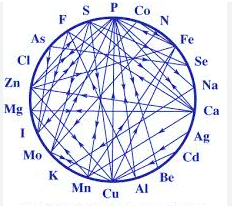Unlocking the Secrets of Hair Tissue Mineral Analysis (HTMA): Your Pathway to Vibrant Energy and Health
In the quest to help others towards optimal health and wellness, we can use a number of diagnostic tools and strategies.
Among these, Hair Tissue Mineral Analysis (HTMA) can provide insight into our body's inner workings.
What exactly is HTMA, and why should you consider it?
Imagine a non-invasive, painless test that provides a comprehensive analysis of your body's mineral content, all from a simple hair sample. This microscopic examination, typically taken from the back of the head, unveils a treasure trove of information about your mineral levels, including both essential elements and potentially harmful heavy metals.
Who May Benefit from HTMA?
Chronic Health Issues: Individuals experiencing persistent health challenges may benefit from uncovering underlying mineral imbalances.
Athletes: Optimizing mineral levels is crucial for athletes aiming to enhance performance and recovery.
Everyone from adults, to kids to your pets: Proactively addressing potential imbalances can potentially prevent future health issues.
So, what sets HTMA apart from traditional blood tests?
While blood tests provide a snapshot of your health at a specific moment, HTMA paints a broader picture, reflecting your body's mineral status over a longer timeframe—usually several months. This means it captures a more comprehensive history of nutrient exposure and imbalances, offering valuable insights that may not be apparent with blood tests alone. For example, we might learn that your body is not pulling calcium into the bones and is dumping it into the tissues instead! The mineral wheel picture to the right shows just how complex minerals can be!
Pros and Benefits:
HTMA provides a holistic perspective on your mineral status, aiding in the identification of imbalances that may contribute to health challenges. It can also give insight into your nervous system, adrenal function, thyroid function, and absorption.
Early Detection: Detecting mineral imbalances early allows for proactive adjustments to prevent potential health issues
Tailored Nutrition: With insights from HTMA, personalized nutrition plans can be crafted to address specific deficiencies and promote overall well-being.
There are no needles involved, making it a stress-free option for those averse to blood draws.
Of course, like any diagnostic tool, HTMA has its limitations and considerations. External factors such as hair treatments and environmental contaminants can impact results, so it's essential to consider these variables when interpreting your report.
But HTMA isn't just about identifying mineral levels; it's about understanding the intricate dance of minerals within our bodies. Minerals serve as the spark plugs of life, orchestrating a symphony of biochemical reactions essential for our well-being. From promoting restful sleep to supporting immune function, managing weight, and beyond, minerals play a vital role in nearly every aspect of our health.
HTMA assesses a wide array of essential minerals like magnesium, calcium, potassium, and zinc, along with trace elements and potentially harmful heavy metals such as lead, mercury, aluminum, and cadmium.
For example:
Magnesium: Deficiency may contribute to muscle cramps, anxiety, and fatigue.
Calcium: Elevated levels may impact cardiovascular health and bone density.
Zinc: A crucial mineral for immune function; deficiency can affect wound healing and immunity.
Copper: Imbalances may influence energy levels and contribute to hormonal issues.
But it's not just about the individual minerals—it's about their relationships and ratios. These ratios provide nuanced insights into various aspects of health, from thyroid function and adrenal health to hormonal balance and metabolic efficiency. Some of these ratios are explained below.
Interpreting HTMA results requires expertise, as it's not simply about identifying high or low levels of specific minerals. It's about understanding the complex interplay between these elements and how they influence our health. A trained healthcare professional or practitioner can help decipher the nuances of your HTMA report, guiding you towards personalized nutrition and supplement plans tailored to your unique needs.
Then what?
Once we receive the results from your Hair Mineral Analysis (HMA) lab, it's time to decode the insights nestled within those numbers.
Again, consulting with a healthcare professional or nutritionist knowledgeable about interpreting HMA results is key. This is not something you can google. They can provide personalized guidance based on your unique profile, helping you understand what the numbers mean for your health and well-being in a broader context.
Depending on the findings, you may need to make adjustments to your diet, lifestyle, or supplementation routine.
We will approach HMA results with a holistic mindset, considering how various factors—such as diet, stress, environmental exposures, and genetic predispositions—may contribute to mineral imbalances. By addressing underlying issues and restoring balance to your body's mineral levels, you can support overall health and well-being for the long term.
You’ll have the option for getting a customized vitamin/mineral supplement to make things easy that is designed just for you!
For people who love details…
Here are some of the ratio’s we can focus on from this functional lab:
Oxidation Rate
The ratio of certain minerals like phosphorous (P) and calcium (Ca) is analysed to determine an individual's oxidation rate. This information can provide insights into the body's ability to neutralise free radicals and manage oxidative stress. This is the primary ratio one must look at to determine if an individual is a slow or fast oxidizer. Calcium is a sedating minerals whereas phosphorus is stimulating.
Thyroid Ratio
The thyroid ratio in HTMA typically involves assessing the balance between minerals like calcium (Ca) and potassium (K). An imbalanced ratio may indicate potential issues with thyroid function. For instance, a calcium-to-potassium ratio that deviates from the norm might suggest hypothyroidism or hyperthyroidism.
Adrenal Function Ratios
Ratios involving sodium (Na) and Magnesium (Mg) as well as sodium (Na) and potassium (K) are often examined to assess adrenal function. Sodium and magnesium/potassium imbalances provide indications of adrenal fatigue and stress. For instance, elevated sodium-to-magnesium as well as elevated sodium-to-potassium ratios suggest acute stress and adrenal overdrive.
Hormonal & Digestive Ratio
Various mineral ratios in HTMA can offer insights into hormonal and digestive health. For example, imbalances involving zinc (Zn) and copper (Cu) may be associated with hormonal and digestive disorders. Proper zinc-to-copper ratios are also crucial for digestive enzyme function, and deviations may indicate issues such as leaky gut or impaired nutrient absorption.
Metabolic Ratio
Ratios involving elements like magnesium (Mg) and calcium (Ca) can provide information about metabolic efficiency. An imbalance in these ratios might indicate issues with insulin sensitivity, blood sugar regulation, or metabolic rate.
Heavy Metal Exposure (Toxic Ratios)
HTMA is also used to assess exposure to toxic heavy metals such as lead, mercury, arsenic, aluminium, and cadmium. Elevated levels of these metals can have detrimental effects on various organ systems and contribute to chronic health conditions. Minerals and heavy metals also share similarities in their chemical structures, and due to these similarities, they can compete for binding sites and receptors within the body. This phenomenon is known as "competitive inhibition" or "competitive binding". Without getting too much into details, it is important to understand the competition of specific minerals and their related heavy metals in order to aid the body with the detoxification process. These specific ratios are named Toxic Ratios on the complete HTMA report.
If you’re interested in learning more, book a free discovery call here.



